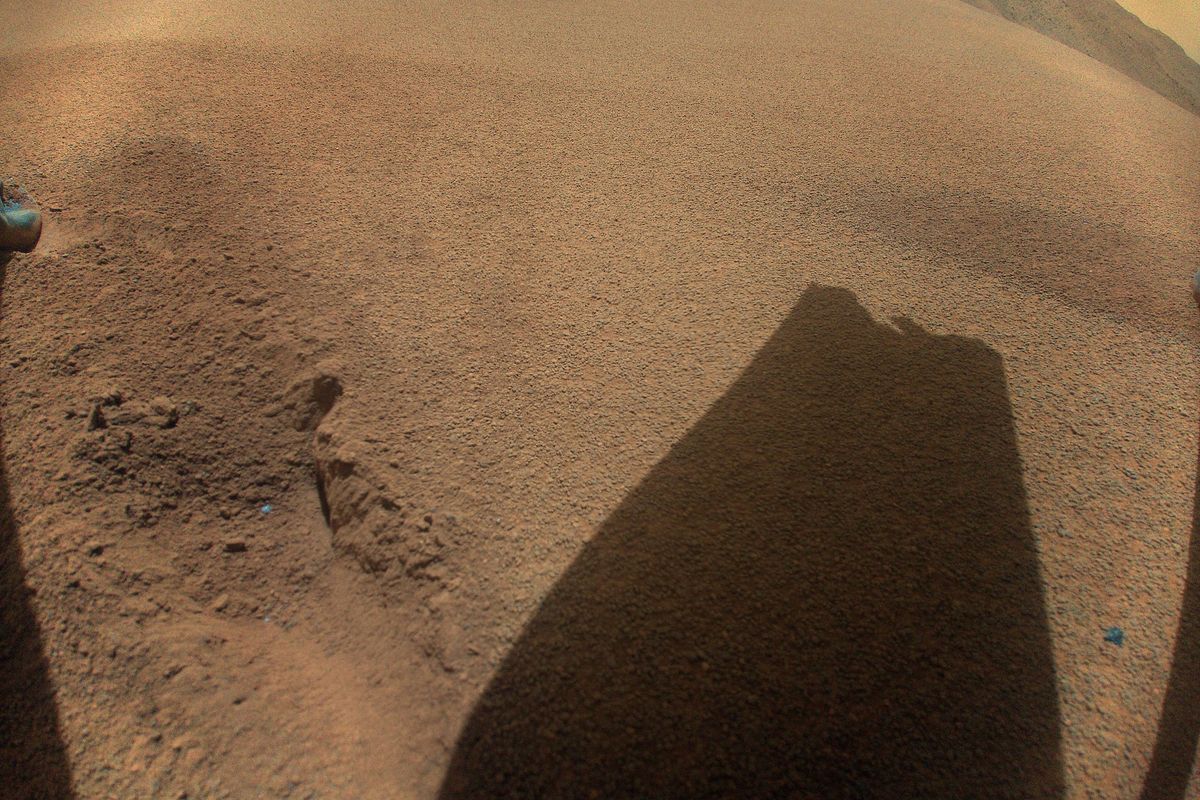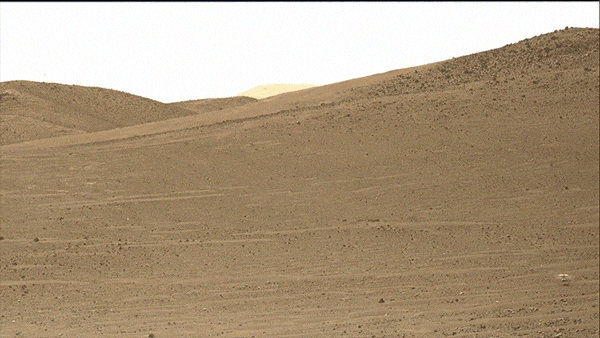Blade Strike on Landing Ends Mars Helicopter’s Epic Journey

The Ingenuity Mars Helicopter made its 72nd and final flight on 18 January. While the helicopter remains upright and in communication with ground controllers," NASA's Jet Propulsion Lab said in a press release this afternoon, imagery of its Jan. 18 flight sent to Earth this week indicates one or more of its rotor blades sustained damage during landing, and it is no longer capable of flight." That's what you're seeing in the picture above: the shadow of a broken tip of one of the helicopter's four 2-foot-long carbon-fiber rotor blades. NASA is assuming that at least one blade struck the Martian surface during a rough landing," and this is not the kind of damage that will allow the helicopter to get back into the air. Ingenuity's mission is over.
 The Perseverance rover took this picture of Ingenuity on on 2 August 2023, just before flight 54.NASA/JPL-Caltech/ASU/MSSS
The Perseverance rover took this picture of Ingenuity on on 2 August 2023, just before flight 54.NASA/JPL-Caltech/ASU/MSSS
NASA held a press conference earlier this evening to give as much information as they could about exactly what happened to Ingenuity, and what comes next. First, here's a summary from the press release:
Ingenuity's team planned for the helicopter to make a short vertical flight on Jan. 18 to determine its location after executing an emergency landing on its previous flight. Data shows that, as planned, the helicopter achieved a maximum altitude of 40 feet (12 meters) and hovered for 4.5 seconds before starting its descent at a velocity of 3.3 feet per second (1 meter per second).
However, about 3 feet (1 meter) above the surface, Ingenuity lost contact with the rover, which serves as a communications relay for the rotorcraft. The following day, communications were reestablished and more information about the flight was relayed to ground controllers at NASA JPL. Imagery revealing damage to the rotor blade arrived several days later. The cause of the communications dropout and the helicopter's orientation at time of touchdown are still being investigated.
While NASA doesn't know for sure what happened, they do have some ideas based on the cause of the emergency landing during the previous flight, Flight 71. [This location] is some of the hardest terrain we've ever had to navigate over," said Teddy Tzanetos, Ingenuity project manager at NASA JPL, during the NASA press conference. It's very featureless-bland, sandy terrain. And that's why we believe that during Flight 71, we had an emergency landing. She was flying over the surface and was realizing that there weren't too many rocks to look at or features to navigate from, and that's why Ingenuity called an emergency landing on her own."
Ingenuity uses a downward-pointing VGA camera running at 30 hertz for monocular feature tracking, and compares the apparent motion of distinct features between frames to determine its motion over the ground. This optical flow technique is used for drones (and other robots) on Earth too, and it's very reliable, as long as you have enough features to track. Where it starts to go wrong is when your camera is looking at things that are featureless, which is why consumer drones will sometimes warn you about unexpected behavior when flying over water, and why robotics labs often have bizarre carpets and wallpaper-the more features, the better. On Mars, Ingenuity has been reliably navigating by looking for distinctive features like rocks, but flying over a featureless expanse of sand caused serious problems, as Ingenuity's Chief Pilot Emeritus Havard Grip explained to us during today's press conference:
The way a system like this works is by looking at the consensus of [the features] it sees, and then throwing out the things that don't really agree with the consensus. The danger is when you run out of features, when you don't have very many features to navigate on, and you're not really able to establish what that consensus is, and you end up tracking the wrong kinds of features, and that's when things can get off track.
 This view from Ingenuity's navigation camera during flight 70 (on 22 December) shows areas of nearly featureless terrain that would cause problems during flights 71 and 72.NASA/JPL-Caltech
This view from Ingenuity's navigation camera during flight 70 (on 22 December) shows areas of nearly featureless terrain that would cause problems during flights 71 and 72.NASA/JPL-Caltech
After the Flight 71 emergency landing, the team decided to try a pop-up" flight next: It was supposed to be about 30 seconds in the air, just straight up to 12 meters and then straight down as a check-out of the helicopter's systems. As Ingenuity was descending, just before landing, there was a loss of communications with the helicopter. We have reason to believe that it was facing the same featureless sandy terrain challenges [as in the previous flight]," said Tzanetos. And because of the navigation challenges, we had a rotor strike with the surface that would have resulted in a power brownout, which caused the communications loss." Grip describes what he thinks happened in more detail:
Some of this is speculation because of the sparse telemetry that we have, but what we see in the telemetry is that coming down towards the last part of the flight, on the sand, when we're closing in on the ground, the helicopter relatively quickly starts to think that it's moving horizontally away from the landing target. It's likely that it made an aggressive maneuver to try to correct that right upon landing. And that would have accounted for a sideways motion and tilt of the helicopter that could have led to either striking the blade to the ground and then losing power, or making a maneuver that was aggressive enough to lose power before touching down and striking the blade. We don't know those details yet. We may never know. But we're trying as hard as we can with the data that we have to figure out those details.
When the Ingenuity team tried reestablishing contact with the helicopter the next sol, she was right there where we expected her to be," Tzanetos said. Solar panel currents were looking good, which indicated that she was upright." In fact, everything was green across the board." That is, until the team started looking through the images from Ingenuity's navigation camera, and spotted the shadow of the damaged lower blade. Even if that's the only damage to Ingenuity, the whole rotor system is now both unbalanced and producing substantially less lift, and further flights will be impossible.
 A closeup of the shadow of the damaged blade tip.NASA/JPL-Caltech
A closeup of the shadow of the damaged blade tip.NASA/JPL-Caltech
There's always that piece in the back of your head that's getting ready every downlink-today could be the last day, today could be the last day. So there was an initial moment, obviously, of sadness, seeing that photo come down and pop on-screen, which gives us certainty of what occurred. But that's very quickly replaced with happiness and pride and a feeling of celebration for what we've pulled off. Um, it's really remarkable the journey that she's been on and worth celebrating every single one of those sols. Around 9 pm tonight Pacific time will mark 1,000 sols that Ingenuity has been on the surface since her deployment from the Perseverance rover. So she picked a very fitting time to come to the end of her mission. -Teddy Tzanetos
The Ingenuity team is guessing that there's damage to more than one of the helicopter's blades; the blades spin fast enough that if one hit the surface, others likely did too. The plan is to attempt to slowly spin the blades to bring others into view to try to collect more information. It sounds unlikely that NASA will divert the Perseverance rover to give Ingenuity a closer look. While continuing on its science mission, the rover will come between 200 and 300 meters of Ingenuity and will try to take some pictures, but that's likely too far away for a good quality image.
 Perseverance watches Ingenuity take off on flight 47 on 14 March 2023.NASA/JPL-Caltech/ASU/MSSS
Perseverance watches Ingenuity take off on flight 47 on 14 March 2023.NASA/JPL-Caltech/ASU/MSSS
As a tech demo, Ingenuity's entire reason for existence was to push the boundaries of what's possible. And as Grip explains, even in its last flight, the little helicopter was doing exactly that, going above and beyond and trying newer and riskier things until it got as far as it possibly could:
Overall, the way that Ingenuity has navigated using features of terrain has been incredibly successful. We didn't design this system to handle this kind of terrain, but nonetheless it's sort of been invincible until this moment where we flew in this completely bland terrain where you just have nothing to really hold on to. So there are some lessons in that for us: We now know that that particular kind of terrain can be a trap for a system like this. Backing up when encountering this featureless terrain is a functionality that a future helicopter could be equipped with. And then there are solutions like having a higher-resolution camera, which would have likely helped mitigate this situation. But it's all part of this tech demo, where we equipped this helicopter to do at most five flights in a pre-scouted area and it's gone on to do so much more than that. And we just worked it all the way up to the line, and then just tipped it right over the line to where it couldn't handle it anymore.
Arguably, Ingenuity's most important contribution has been showing that it's not just possible but practical and valuable to have rotorcraft on Mars. I don't think we'd be talking about sample recovery helicopters if Ingenuity didn't fly, period, and if it hadn't survived for as long as it has," Teddy Tzanetos told us after Ingenuity's 50th flight. And it's not just the sample return mission: JPL is also developing a much larger Mars Science Helicopter, which will owe its existence to Ingenuity's success.
Nearly three years on Mars; 128 minutes and 11 miles of flight in the Martian skies. I look forward to the day that one of our astronauts brings home Ingenuity and we can all visit it in the Smithsonian," said Director of JPL Laurie Leshin at the end of today's press conference.
I'll be first in line.
We've written extensively about Ingenuity, including in-depth interviews with both helicopter and rover team members, and they're well worth rereading today. Thanks, Ingenuity. You did well.
Team lead Teddy Tzanetos on the helicopter's milestone aerial mission
A Mars rover driver explains just how much of a difference the little helicopter scout is making to Mars exploration
Simulation is the secret to flying a helicopter on Mars
The Perseverance rover's Mars Helicopter (Ingenuity) will take off, navigate, and land on Mars without human intervention